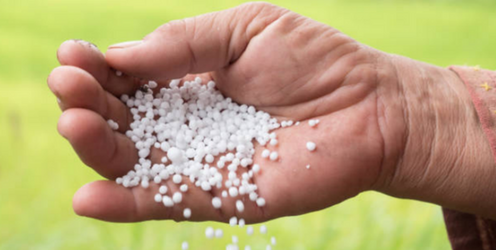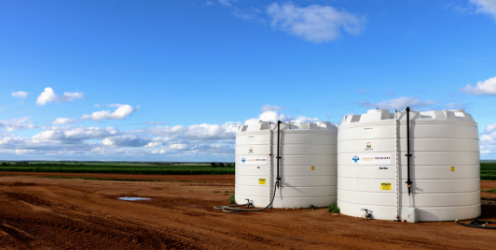Farming is big business in Australia, with more than 50 percent of our total land area being used for agriculture. Our food exports are worth more than $30 billion annually. Farmers have been relying on fertilisers to replenish nutrients in the soil that are lost during the farming process since the dawn of agriculture.
From small farmers to huge commercial farms, liquid fertilisers have consistently gained traction over the years in becoming the go-to choice.
What is there more to know about liquid fertiliser? Browse through the questions and answers below:
- What is a liquid fertiliser?
- What is a liquid fertiliser used for?
- What are the types of liquid fertiliser?
- What are the different ways of applying liquid fertiliser?
- What are the benefits of liquid fertiliser?
- What are the differences between liquid vs solid fertilisers?
- Is liquid fertiliser better than granule?
- How fast does liquid fertiliser work?
- How best to store liquid fertiliser?
- Bonus: Liquid fertiliser storage tank guidelines for success
- Liquid fertiliser transport system
What is a liquid fertiliser?
Liquid fertiliser (also known as fluid fertiliser) is an alternative to solid fertiliser (alternatively known as granular fertiliser). In other words, it’s a nutrient-containing fertiliser in liquid form, known to several benefits from more even application to quick nutrient uptake.
What is a liquid fertiliser used for?
Liquid fertilisers are used in large scale crop farming, particularly in non-wetting (water-repellent) soils and dry sowing conditions. The liquid form offers a much better chance of penetrating the soil, making nutrients immediately available to crops.
For information on the pros and cons of liquid and solid fertilisers, see the section under "Liquid vs solid fertiliser."
What are the types of liquid fertiliser?
Different brands contain different formulations. The most common ingredients used are Nitrogen, Phosphorous, and Potassium.
The following are the purpose of the different ingredients:
Nitrogen
Nitrogen helps plants synthesise energy necessary to stimulate growth and enhance the production of high-quality fruits or seeds.
Potassium
The element is critical to the healthy development of crop roots, fruits, and leaves. Plants need it to stimulate food production as well as boost their immunity against infections and diseases.
Phosphorous
Crops use phosphorous to grow to optimal maturity and strength. The nutrient enhances fruit production by promoting energy transmission throughout the crop's structure.
Calcium
Plants need this nutrient to build a solid cell wall structure as well as optimise the availability and transfer of other minerals.
Liquid fertiliser brands come in a variety of forms and compositions. Flexi-N fluid fertilisers contain nitrate, ammonium, and urea, while Flexi-NK contains nitrogen (in urea form) and potassium (chloride form). Summit UAN contains nitrogen in ammonium, nitrate, and urea forms.
We cover the different raw materials and the composition of different brands in this related topic:
Liquid Fertiliser: Essential to Broadacre—Will Its Supply Chain Affect You?
What are the different ways of applying liquid fertiliser?
Liquid fertilisers can be applied to the ground or foliarly, meaning directly to the leaves. Foliar applications make the fertiliser more readily available to the plant. However, foliar application tends to not last the entire season. Conversely, ground applied liquid fertiliser lasts longer, usually the entire season.
Many farmers use both methods, applying to the ground at the beginning of the season, then using foliar applications to correct mid-season deficiencies.
What are the benefits of liquid fertiliser?
Some of the main benefits of liquid fertiliser include easy blending, application, and handling once the proper equipment is in place. Combining the fertiliser you need is also easier when done in liquid form.
When blended with crop protection products, fluid fertiliser can deliver a double benefit to your paddocks in a single pass for an entire season. Liquid fertiliser also distributes nutrients more evenly than granular fertiliser.
See below for a more detailed comparison between solid and liquid forms.
What are the differences between liquid vs solid fertilisers?

The points below are the main differences between solid and liquid fertilisers. As you read through them, you may discover smart strategies that will help you get the most of your time and effort.
Speed of action
Liquid: Fast-acting. Ideal for water-repellent soils and dry-sowing conditions. Don’t need to be broken down by water from the soil, making them more readily absorbed by the roots. Ideal if fast nutrient uptake is needed.
Solid: Slow-acting. Must first be broken down by water from the soil. Ideal if the slow release of nutrient uptake is desired.
Uniformity of application
Liquid: Allow for a more uniform application. Fluid fertilisers are also said to seep into the soil and distribute nutrients more evenly than granular fertilisers, giving crops a more consistent coating.
Solids: Due to it being solid, it can be applied in patterns throughout the paddock that may not be uniform. The result is less consistent results.
Water requirements at the time of application
Liquid: Needs to be mixed with quality water or rainwater to penetrate the soil and for nutrients to access plant roots easily.
Solid: No irrigation or rainwater is needed during applications. This entails that the soil itself will have enough water content to help break down the granules.
Re-application
Liquid: Can provide an additional boost during the growing season. With liquid fertiliser tanks, it’s easy to tailor a second application to the needs of your plants that year, delivering it in-season. This can be helpful once the season's sun and rain have been noted and using your customised blend of fertiliser components, you can deliver exactly what your crops need for that particular growing season.
Alternatively, liquid fertilisers can be blended with crop protection products and applied once.
Solid: Most fertilisers in the granular form are delivered in one large dose before the season. If you don’t have enough time in your hands to apply fertiliser more than once a year, solid fertiliser, being slow-release, can be an advantage being a one-time application.
Uptake
Liquid: Liquid fertiliser is homogenous. Meaning that every drop of the liquid contains the desired mixture or contains the same proportion. The liquid formula makes elements like phosphorus more mobile, helping it to reach the roots more easily.
Solid: Some of these nutrients, like phosphorus, may be less "mobile" than others. If the granule doesn't penetrate the ground, the roots don't get any phosphorus.
Additionally, some granular fertilisers can have a high salt content and burn the seed as a result. Or in banding applications, the plant may steer clear of a vital nutrient with higher salt content and miss out on the other nutrients as a result (e.g. plant roots may avoid the nitrogen component of the fertiliser, consequently limiting its access to phosphate granules in the band).
Is liquid fertiliser better than granule?
Although both fluid and solid fertilisers each come with their advantages and disadvantages, liquid fertiliser has more advantages when it comes to broadacre cropping.
Ultimately, it all boils down to what works best for you and the equipment you already have at your disposal.
How fast does liquid fertiliser work?
Urea based liquid fertilisers take approximately 5 days to work. However, environmental conditions like temperature and humidity levels also affect how slow or how fast it will work. As an aside, it takes just a few minutes for the liquid fertiliser to be absorbed into the crops’ nutrient stream.
How best to store liquid fertiliser?

Most fertilisers are manufactured, concentrated nutrients that must be stored properly. Fertilisers can be harmful if they contaminate surface or ground water. Minimise the risks by keeping fertilisers safely stored away from other chemicals, and in dry conditions. To ensure safety, choose a liquid fertiliser tank known for durability.
Bonus: Liquid fertiliser storage tank guidelines for success
Here are related topics that’ll help ensure you’re well-informed:
Are Poly Liquid Fertiliser Tanks Ideal for Liquid Fertiliser Long-term Storage?
Things to Do to Avoid a Catastrophic Liquid Fertiliser Storage Tank Failure
All About Liquid Fertiliser Tanks and Liquid Fertiliser Weight
Liquid fertiliser transport system
For information on liquid fertiliser transport tanks and systems, explore these related topics below:
A Guide to Choosing the Right Liquid Cartage Tank
Liquid Cartage Tank Setup: 8 Features to Consider to Boost Productivity
Getting started with liquid fertiliser, if you choose it, does require some upfront expenditure, but you can make that money up over time through increased crop yields.
Contact us to learn more about our range of high-quality, approved liquid fertiliser tanks.
If you’re still undecided which liquid fertiliser tank material to choose, read this related topic below:
Cartage Tanks: Poly vs. Fibreglass vs. Steel, Which Should You Choose?









What do you think about this post?
Comments